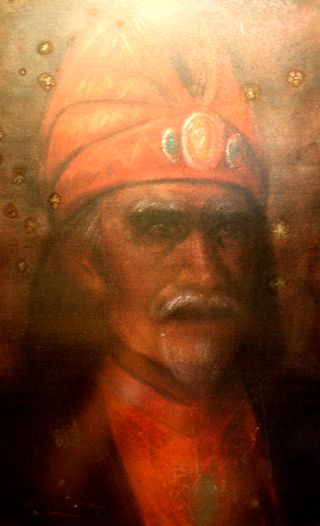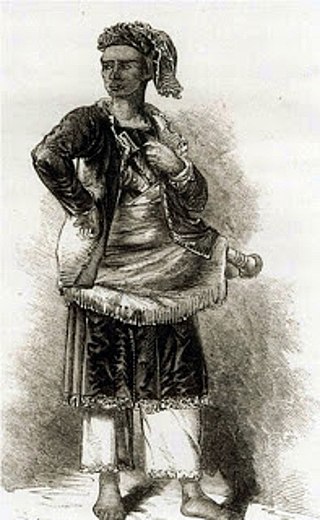The Malay language has a complex system of styles, titles and honorifics which are used extensively in Brunei Darussalam, Malaysia and Singapore.

Omar Ali Saifuddien Sa'adul Khairi Waddien was the 28th Sultan of Brunei, reigning from 1950 until his abdication in 1967.

The Johor Sultanate was founded by Sultan of Malacca Mahmud Shah's son, Alauddin Riayat Shah II in 1528.

Bendahara Paduka Raja Tun Perak was the fifth and most famous bendahara, a Malay rank similar to a prime minister, of the Sultanate of Malacca. He served under four sultans from 1456 to 1498. Early in his life, Perak was a soldier-statesman for Malaccan rulers. In 1445, he led the Malaccan army to victory by defeating Siamese invaders. As a result, he was made bendahara in 1456.

Sultan 'Abdul Momin was the 24th Sultan of Brunei from 1852 until his death in 1885.

The Sultan of Johor is a hereditary seat and the sovereign ruler of the Malaysian state of Johor. In the past, the sultan held absolute power over the state and was advised by a bendahara. Currently, the role of bendahara has been taken over by first minister with the constitutional monarchy system via Johor State Constitution. The sultan is the constitutional head of state of Johor. The sultan has his own independent military force, the Royal Johor Military Force. The sultan is also the Head of Islam in Johor state.
Tun Muhammad bin Tun Ahmad, better known as Tun Sri Lanang, was the Bendahara of the royal Court of Johor Sultanate who lived between the 16th and 17th centuries. He served under two Sultans of Johor, namely; Sultan Ali Jalla Abdul Jalil Shah II (1570–1597) and Sultan Alauddin Riayat Shah III (1597–1615) and also advisers to 3 Acheh sultans namely; Sultan Iskandar Muda, Sultan Iskandar Thani (1636–1641) and Sultana Tajul Alam Safiatuddin Shah (1641–1675). He had two honorific titles throughout his lifetime; as the Bendahara of Johor, Bendahara Paduka Raja Tun Mohamad, while he was given the title of Orang Kaya Dato' Bendahara Seri Paduka Tun Seberang after settling in Aceh.
Muhammad Hasan ibni Saiful Rijal Nurul Alam, also known as Marhum di Tanjung, was the tenth Sultan of Brunei from 1582 to 1598. Under him, the Bruneian Empire had apparently full control of the island of Borneo and Northern Philippines, including Sulu.
Dato' Bendahara Seri Maharaja Tun Habib Abdul Majid was the 19th Bendahara of the Johor Sultanate during the late 17th century. The Johor Sultanate under Sultan Mahmud Shah II saw a gradual decline of royal authority during Tun Habib's tenure as the Bendahara of Johor. Internal challenges within the Sultanate faced by Tun Habib consolidated his power as the Bendahara, in which case the Bendahara monopolised legitimate authority over the Johor Sultanate by the 1690s. After his death, Tun Habib's descendants spanned throughout the Johor Sultanate and established ruling houses in Riau-Lingga, Johor, Pahang and Terengganu.
Sri Paduka Dato' Bendahara Sri Maharaja Tun Muhammad Tahir ibni Almarhum Dato' Bendahara Sri Maharaja Tun Ali was the fifth Raja Bendahara of Pahang who ruled the state until his death in 1863 in the Pahang Civil War.
Muhammad Ali ibni Muhammad Hasan, also known as Marhum Tumbang Di Rumput, was the 13th Sultan of Brunei. His murder would later go on to spark the beginning of the Brunei Civil War between his killer and Sultan Muhyiddin, which a protracted civil war of succession that broke out and lasted for several years.
Abdul Hakkul Mubin ibni Muhammad Panjang, also known as Abdul Mubin or Al-Marhum di Pulau, was the 14th Sultan of Brunei. He was involved in the Brunei Civil War and ruled the sultanate from 1661 to 1673, after killing his uncle, Sultan Muhammad Ali.
Abdul Jalilul Akbar ibnu Muhammad Hasan, also known as Marhum Tua, was the eleventh Sultan of Brunei. Reigning for 61 years from 1598 until 1659, Abdul Jalilul Akbar is the longest reigning Sultan of Brunei to date.

The Royal Brunei Mausoleum is a Royal Mausoleum of Brunei located at Jalan Tutong, Bandar Seri Begawan, Brunei. The Mausoleum is the main resting place and burial ground for several Sultans of Brunei and members of the Royal Family. The Royal Mausoleum was opened during the reign of Sultan Omar 'Ali Saifuddin I who later became the first monarch to be buried in the Mausoleum when he died in 1795.

Pengiran Anak Mohamed Alam OBE was a nobleman and politician whom became the fourth Speaker of the Brunei Legislative Council from 1971 until 1974 and Chief of Jabatan Adat Istiadat Negara. He was the father of Pengiran Anak Saleha, the queen consort of Hassanal Bolkiah, the current Sultan of Brunei. He was also the uncle and father-in-law of the Sultan. He was also a maternal grandfather of Al-Muhtadee Billah, the Crown Prince.

The Pahang Sultanate also referred as the Old Pahang Sultanate, as opposed to the modern Pahang Sultanate, was a Malay Muslim state established in the eastern Malay Peninsula in the 15th century. At the height of its influence, the sultanate was an important power in Southeast Asia and controlled the entire Pahang basin, bordering the Pattani Sultanate to the north and the Johor Sultanate to the south. To the west, its jurisdiction extended over parts of modern-day Selangor and Negeri Sembilan.

The Bendahara dynasty is the current ruling dynasty of Pahang, Terengganu and Johor Sultanate, a constituent state of Malaysia. The royal house were of noble origin, holding the hereditary position of Bendahara in the courts of Singapura, Melaka and Old Johor since at least from the end of the 13th century.

Sultan Omar Ali Saifuddien College, abbreviated as SOASC, is a government boys' secondary school in Bandar Seri Begawan, the capital of Brunei. It is the first secondary school in the country. The school is also one of the only three boys' secondary schools nationwide, with the other two being Muda Hashim Secondary School and Ma'had Islam Brunei. The school provides five years of secondary education leading up to GCE 'O' Level and IGCSE qualification.

Pengiran Anak Damit was Queen of Brunei as the wife of the 28th Sultan of Brunei, Omar Ali Saifuddien III.
The Wazir are a group of royal dignitaries within the Sultanate of Brunei whose position ranks the second-highest official in the country behind the Sultan. The vizier had formerly held the position of the Sultan's highest official in the administration of the then-reigning government throughout Brunei's history, particularly during the times prior to and after the British protectorate. The core of Brunei's nobility consisted of this class of governmental offices, and it consists of a Perdana Wazir, and four Wazir under him, namely Bendahara, Di-Gadong, Pemancha and Temenggong. Notably, they are sometimes referred to as and acted as senior ministers.











